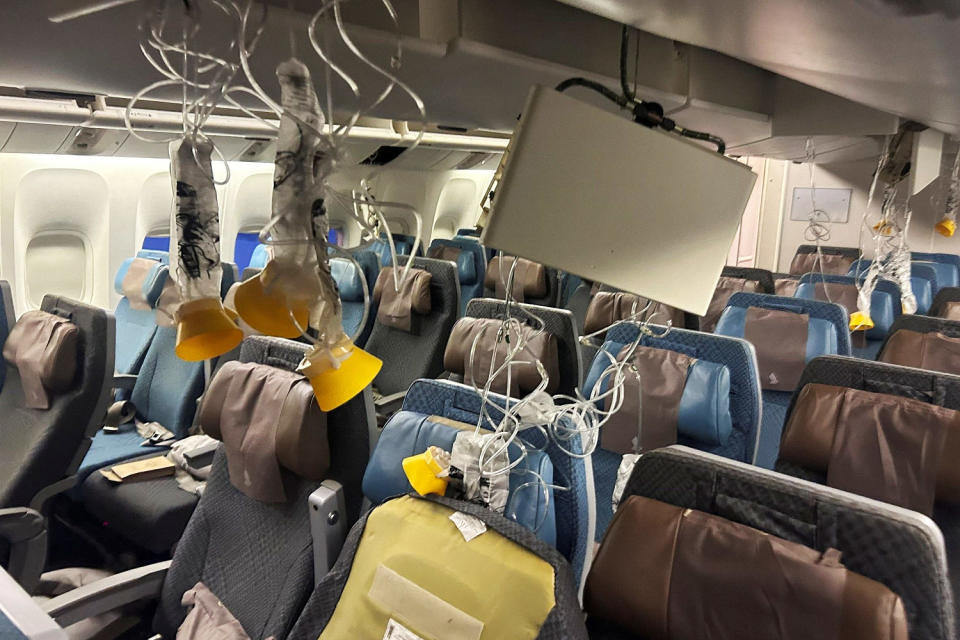Climate change and turbulence: Experts weigh in after death on Singapore Airlines flight
One passenger died and 30 others were injured aboard a Singapore Airlines flight that was hit by "severe turbulence," officials said Tuesday, but experts say such deaths are rare even as researchers warn climate change may be causing more extreme cases of turbulence.
Since 2009, the National Transportation Safety Board said, the U.S. has not had any turbulence-related deaths aboard large commercial planes, such as the Boeing aircraft that encountered sudden extreme turbulence over the Irrawaddy River in Myanmar at 37,000 feet.
A 73-year-old passenger who had some medical problems died, possibly from cardiac arrest, and at least seven people were critically injured, Kittipong Kittikachorn, general manager of Bangkok’s Suvarnabhumi Airport, said at a news conference Tuesday.

The cause of the turbulence is under investigation. Singapore Airlines said the Singapore-bound flight from London encountered severe turbulence about 10 hours after departure.
Death by turbulence rarely occurs, but severe encounters are not uncommon, according to Larry Cornman, a physicist and project scientist with the U.S. National Science Foundation National Center for Atmospheric Research.
“Often, for something like this, it’s just wrong place, wrong time,” said Cornman, who studies small-scale motions of the atmosphere that could endanger aircraft.
Out of millions upon millions of flights, turbulence has caused 185 serious injuries from 2009 to 2023, the latest year with publicly available data, according to the National Transportation Safety Board.
The agency, which requires airlines to report injuries and deaths, categorizes a serious injury as any that requires more than two days of hospitalization; involves any internal organ; or results in bone fractures, second- or third-degree burns, severe hemorrhages, or nerve, muscle or tendon damage.
Of the reported incidents from 2009 to 2022, at least 129 crew members and 34 passengers were injured.
Turbulence-related deaths can be caused by heart attacks or head injuries if a passenger’s head strikes the ceiling or gets hit by falling luggage, Cornman said.
“Anything that could cause a death on the ground can certainly cause it inside an aluminum tube at 35,000 feet,” he said, adding that seat-belted passengers should still feel safe in the skies.
“These large transport aircraft are built quite strongly. They will not fall apart or come out of the sky due to turbulence,” Cornman said.
Sara Nelson, president of the Association of Flight Attendants-CWA, said initial reports appear to indicate that the Singapore flight encountered clear-air turbulence — the most dangerous type because it cannot be seen and is virtually undetectable with current technology.
“One second, you’re cruising smoothly,” Nelson said. “The next, passengers, crew and unsecured carts or other items are being thrown around the cabin.”
Nelson and a group of researchers say such incidents of clear-air turbulence — which is difficult to forecast and avoid because it is not associated with storms — are on the rise due to climate change.
A 2023 study published in the journal Geophysical Research Letters found that severe clear-air turbulence increased by more than 50% over the North Atlantic Ocean from 1979 to 2020.
The uptick in turbulence likely owes to the effect of climate change on wind speeds in the upper levels of the atmosphere, the researchers found. Some of the most pronounced increases in clear-air turbulence in recent decades were over mid-latitude regions, including over the North Atlantic and flight routes over the United States, according to the study.
The results suggest that global warming may be driving instability in the jet stream, a conveyor belt of fast-moving air that encircles the globe over the Northern Hemisphere, said Mark Prosser, co-author of the study and a doctoral researcher at the University of Reading in the United Kingdom.
The jet stream, which flows like a river of air from west to east, is fueled by temperature differences between cooler regions to the north and warmer air masses to the south. Climate change may be throwing the jet stream off-kilter, which could have enormous implications for future air travel, Prosser said.
“Planes like to fly with the jet stream,” he said, “but where planes like to fly is also ironically where all the turbulence is.”
That instability is expected to increase as the world warms. Prosser’s colleagues at the University of Reading separately used climate models to project how clear-air turbulence in the latter half of this century may shift if global warming continues. The researchers found that increasing greenhouse gas emissions also increased turbulence and instability.
“If you compare the climate of 2050 to 2080 with the climate before we started emitting greenhouse gases — so, preindustrial times — there was a doubling, or tripling sometimes, of the amount of clear-air turbulence in the atmosphere,” Prosser said.
A total of 211 passengers and 18 crew members were on the Singapore Airlines flight when it was jolted midair, the airline said in a statement. The plane suddenly fell from 37,000 feet to 31,000 feet within five minutes, according to flight-tracking site FlightAware.
The pilot declared a medical emergency and diverted the plane to Thailand’s capital, Bangkok, where it landed at 3:45 p.m. local time (4:45 a.m. ET), the airline said.
Officials did not release the identity of the deceased passenger Tuesday.
The people on the flight hailed mostly from Australia, the United Kingdom, Singapore and New Zealand, the airline said. Four passengers were from the United States.
“Singapore Airlines offers its deepest condolences to the family of the deceased,” the statement said. “We deeply apologise for the traumatic experience that our passengers and crew members suffered on this flight.”
This article was originally published on NBCNews.com

